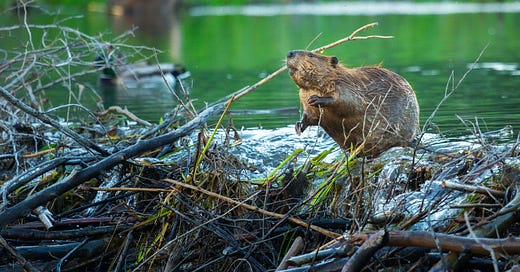It occurs to me that beavers probably brought a lot of extra rain to Europe and North America
These small furry creatures, a member of the rodent family, first appeared millions of years ago in Eurasia, and then trooped across a snowy land bridge that connected Siberia and Alaska, to spread to North America. They dreamed of ponds and watery lodges, and were willing to work hard for their dreams. Their teeth chiseled at aspen, birch, cottonwood, alder and poplar to create deadwood that slowed rivers and creeks, and created eddies, snags, and creek bottoms of organic matter.
The beavers were primordial, small water cycle architects. They were the original ‘slow it, sink it, spread it’ engineers. Under their diligent ways, the water courses turned into pond-creek-pond-creek-pond-creek, and the underground labyrinth of aquifers filled up.
As beavers multiplied, the amount of wetland evaporation increased, which added to the ocean moisture blowing inland to create more rain. That extra rain led to more trees. More trees meant more transpiration, which led to even more rain.
A positive feedback loop, and ever-increasing returns led to two continents full of beavers, wetlands, forests, and groundwater. In Europe beavers reached numbers of around 10-20 million, and in North America beavers attained numbers of about 100-400 million. The total freshwater they created was about 200 billion cubic meters, enough for an army of invisible mist to cascade interminably upwards, bringing millenia after millenia of verdant rain.
[A 1860 map, from Upper Michigan Peninsula, of beaver created ponds, with the circles representing ponds that had been filled in.
[Same place today. Pictures from A Rattlin Blog]
….
This is a reader supported publication







Yes! More beavers now! Re-beaver the planet!
Alpha Lo, I thought you might find this interesting:
Beavers, the small water cycle & atmospheric chemistry.
https://lachefnet.wordpress.com/2024/12/24/beavers-the-small-water-cycle-atmospheric-chemistry/
.....